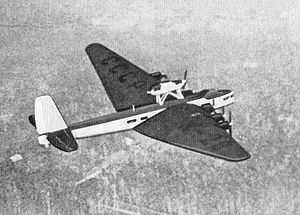Tupolev ANT-20
| ANT-20 | |
|---|---|
 | |
| ANT-20 "Maksim Gorky" | |
| Role | Propaganda aircraft/Transport |
| National origin | Soviet Union |
| Manufacturer | Tupolev |
| First flight | 19 May 1934 |
| Introduction | 1934 |
| Retired | 1942 |
| Primary user | Soviet Union |
| Number built | 2 |
| Developed from | Tupolev TB-4 |
The Tupolev ANT-20 Maksim Gorky (Russian: Туполев АНТ-20 "Максим Горький") was a Soviet eight-engine aircraft, the largest of the 1930s. Its wingspan was similar to that of a modern Boeing 747.
Overview
The ANT-20 was designed by Andrei Tupolev, using the all-metal airframe technologies devised by German engineer Hugo Junkers during the World War I years, and constructed between July 4, 1933 and April 3, 1934. It was one of two aircraft of its kind built by the Soviets. The aircraft was named after Maxim Gorky and dedicated to the 40th anniversary of his literary and public activities. The ANT-20 was the largest known aircraft to have used the Junkers design philosophy of corrugated sheet metal for many of the airframe's key components, especially the corrugated sheet metal skinning of the airframe.
It was intended for Stalinist propaganda purposes and was equipped with a powerful radio set called "Voice from the sky" ("Голос с неба", Golos s neba), printing machinery, library, radiostations, photographic laboratory, and a film projector with sound for showing movies in flight. For the first time in aviation history, this aircraft was equipped with a ladder, which would fold itself and become a part of the floor.[1]
Also, for the first time in aviation history, the aircraft used not only direct current, but also alternating current of 120 volts. The aircraft could be dismantled and transported by railroad if needed. The aircraft set several carrying capacity world records and is also the subject of a 1934 painting by Vasily Kuptsov, in the collection of the Russian Museum at St. Petersburg.
1935 Maksim Gorky crash
On May 18, 1935, the Maxim Gorky (pilots – I. V. Mikheyev and I. S. Zhurov) and three more planes (Tupolev ANT-14, R-5 and I-5) took off for a demonstration flight over Moscow. The main purpose of the other three planes flying so close was to make evident the difference in size. As a result of a poorly executed loop maneuver (a third such stunt on this flight) around the plane performed by an accompanying I-5 fighter (pilot – Nikolai Blagin), both planes collided and the Maxim Gorky crashed into a low-rise residential neighborhood west of present-day Sokol metro station.
Forty-five people were killed in the crash, including both pilots and their 33 passengers, family members of some of those who had built the aircraft. (While authorities announced that the fatal maneuver was impromptu and reckless, it has been recently suggested that it might have been a planned part of the show.) Also killed was the fighter pilot, Blagin, who was made a scapegoat in the crash and subsequently had his name used eponymously (Blaginism) to mean, roughly, a "cocky disregard of authority." However, Blagin was given a state funeral at Novodevichy Cemetery together with ANT-20 victims.
ANT-20bis

A replacement aircraft, designated ANT-20bis had begun production the following year and first flew in 1938. It was largely identical in design but with six more-powerful engines. This plane, designated PS-124 and registered CCCP-L760, served with Aeroflot on transport routes in Russia and Uzbekistan. On December 14, 1942, it also crashed after the pilot allowed a passenger to take his seat momentarily and the passenger apparently disengaged the automatic pilot, sending the airplane into a nosedive from an altitude of 500 m (1,500 ft) and killing all 36 on board.[2]
Plans to build a fleet of ANT-20bis aircraft were abandoned in 1939 as Joseph Stalin's purges of the aviation industry had resulted in a shortage of qualified engineers.
Operators
Specifications
Data from The Osprey Encyclopedia of Russian Aircraft 1875–1995 [3]
General characteristics
- Crew: 8
- Capacity: 72
- Length: 32.90 m (107 ft 11¼ in)
- Wingspan: 63.00 m (206 ft 8¼ in)
- Height: 10.6 m[4] (34 ft 9¼ in)
- Wing area: 488 m² (5,251 ft²)
- Empty weight: 28,500 kg (62,700 lb)
- Loaded weight: 42,000 kg (92,400 lb)
- Max. takeoff weight: 53,000 kg (116,600 lb)
- Powerplant: 8 × Mikulin AM-34FRN V-12 liquid cooled, 671 kW (900 hp) each
Performance
- Maximum speed: 220 km/h (119 kn, 137 mph) at sea level
- Range: 1,200 km (652 nmi, 750 mi)
- Service ceiling: 4,500 m (14,764 ft)
See also
- Related development
- Tupolev TB-4
- Aircraft of comparable role, configuration and era
- Related lists
References
- ↑ "News Paper Printed On Plane In Flight" Popular Science Monthly, March 1935, cutaway drawing of interior
- ↑ Accident description for CCCP-L760 at the Aviation Safety Network. Retrieved on 2014-10-15.
- ↑ Gunston 1995, p.396.
- ↑ on ground (tail down, over centre prop)
- Gunston, Bill (1995). The Osprey Encyclopedia of Russian Aircraft 1875–1995. London: Osprey Publishing. ISBN 1-85532-405-9.
- Shavrov, V. B. (1985). Istoriya konstruktskii samoletov v SSSR do 1938 g. (3 izd.) (in Russian). Mashinostroenie. ISBN 5-217-03112-3.
- "The "Maxim Gorky"", Flight, 9 August 1934: 8l2
External links
| Wikimedia Commons has media related to Tupolev ANT-20. |
- Maxim Gorky Memorial at Find a Grave
- Russian: Nikolai Blagin, biography Babelfish rough English translation here
- Short article on the ANT-20 (formerly linked video clip is no longer accessible)
- Catastrophe of Maxim Gorky Babelfish rough English translation from Russian History of Aviation, Publ Young Guards (1936)
- The short film War Dept. Military Intelligence Film "Russian Air Show" is available for free download at the Internet Archive
| ||||||||||||||||||||||||||
| ||||||||||
| ||||||||||||||||||||||